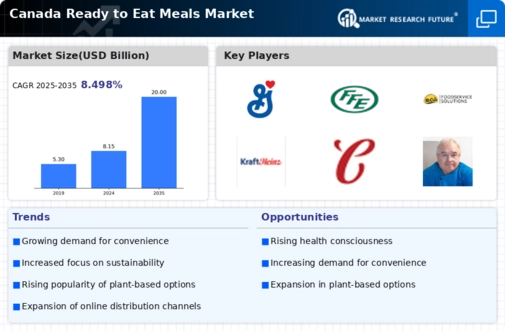Rising Disposable Income
As disposable income levels in Canada continue to rise, consumers are increasingly willing to spend on premium ready to-eat meals. This trend is particularly evident among urban populations, where higher income brackets are prevalent. The ready to-eat-meals market benefits from this shift, as consumers seek quality and variety in their meal choices. Data indicates that the average disposable income in Canada has seen an increase of approximately 3% annually, allowing more individuals to invest in convenient meal options. This financial flexibility suggests a potential for growth in the market, as consumers are likely to explore diverse offerings that enhance their dining experience.
Convenience and Time-Saving
The increasing pace of life in Canada has led to a growing demand for convenience in meal preparation. Busy professionals, students, and families often seek quick meal solutions that do not compromise on quality. The ready to-eat-meals market caters to this need by offering a variety of options that can be consumed with minimal preparation time. According to recent data, approximately 60% of Canadian consumers prioritize convenience when selecting meals. This trend is likely to continue, as more individuals value time-saving solutions in their daily routines. The ready to-eat-meals market is thus positioned to thrive, as it aligns with the lifestyle preferences of a significant portion of the population.
Evolving Consumer Preferences
Consumer preferences in Canada are evolving, with a growing inclination towards diverse and international cuisines. This trend is influencing the ready to-eat-meals market, as consumers seek out meals that offer unique flavors and culinary experiences. The demand for ethnic and fusion meals has surged, with a reported increase of 30% in sales of such products over the last year. The ready to-eat-meals market is responding by expanding its product lines to include a wider array of global flavors, catering to adventurous eaters and those looking to explore new tastes. This evolution in consumer preferences suggests a dynamic market landscape, ripe for innovation and growth.
Health-Conscious Consumer Behavior
There is a notable shift towards health-conscious eating among Canadian consumers, which significantly impacts the ready to-eat-meals market. As awareness of nutrition and wellness increases, individuals are more inclined to choose meals that align with their health goals. This trend is reflected in the growing demand for meals that are low in calories, high in protein, and free from artificial additives. Approximately 45% of Canadians report that they actively seek healthier meal options. The ready to-eat-meals market is adapting to this demand by introducing a range of nutritious offerings, thereby appealing to a health-focused demographic that prioritizes well-being in their food choices.
Technological Advancements in Food Production
Technological innovations in food production and preservation are transforming the ready to-eat-meals market. Advances such as vacuum sealing, flash freezing, and improved packaging techniques enhance the shelf life and quality of meals. These technologies not only ensure food safety but also maintain the nutritional value of the products. In Canada, the adoption of such technologies has led to a 20% increase in the availability of ready to-eat meals in retail outlets over the past year. The ready to-eat-meals market is likely to continue benefiting from these advancements, as they enable manufacturers to meet consumer demands for freshness and convenience.























Leave a Comment